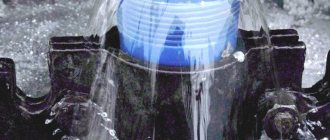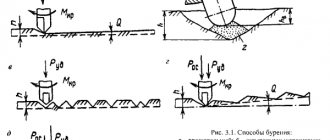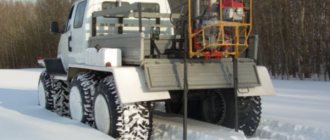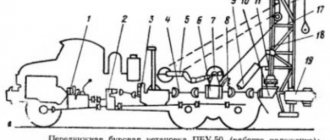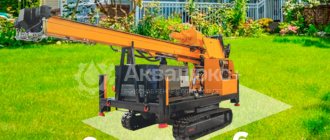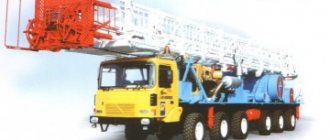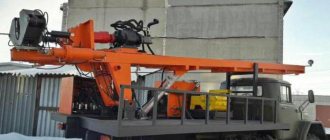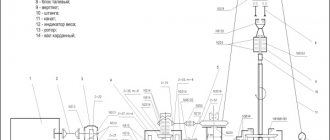Wherever the house or dacha is located, access to clean water is one of the basic conditions for an organized home life. A drilling rig for drilling water wells helps you get constant access to drinking water. Let's figure out what mechanisms will help solve this large-scale problem, what features and application possibilities they have.
Water on the site is the key to comfortable living Source mdsg.ru
Pros of professional and homemade drilling rigs
Often the only source of water for a private household is a well, and the level of the aquifer can be located at a depth of 50-100 meters or more. A specialized mechanism will help you get to this depth.
Large-sized drilling equipment, capable of not only drilling water wells, but also carrying out engineering and geological surveys, is rarely used in built-up areas. It is difficult or impossible for such rigs to enter the territory, so the only option is to use small-sized drilling rigs.
Professional small-sized drilling rigs for wells (MGDU) are universal units that allow you to perform drilling operations of different types and in different ways (including drilling an artesian well). The use of MGBU on private plots has the following advantages:
- Drilling operations can be carried out where large equipment cannot pass.
- Thanks to the use of electricity, the cost of work is reduced.
Minimal damage will be caused to the site Source santex-mir.ru
- Small dimensions allow you to preserve the surrounding area in its original form; minimal damage is caused to the soil.
Professional mechanisms work quickly and efficiently, but their use is not always justified, and the cost of services is prohibitive for many farms. For industrially manufactured units, there is an alternative: homemade devices that can cope with drilling efficiently.
Of course, you should not purchase or build such equipment for one single use. But it makes sense to gain experience, which can then become a source of stable income. Drilling is a process that is in demand not only for water supply, but also, for example, during the construction of foundations.
Homemade units have a small power, which is not enough to drill an artesian well, the average depth of which starts from 100-150 m. But their resources are enough to make a well of average depth (20-40 m).
MGBU helps organize water supply for a private home Source par-torg.com
Homemade installations for drilling water wells are actively used in private households for the following reasons:
- Compact dimensions and low weight make the unit easy to transport and install. To relocate to a new location, you will not need to look for special equipment for transportation.
- Easy assembly/disassembly, simple operation. During operation, a home-made installation, like a professional one, can be connected to an electrical network or to an alternative source, which ensures quick completion of the work.
- A well can be drilled in a confined space (basement, garage) if the ceiling height exceeds 2 m.
How oil is extracted.
We were unlucky with oil. If in Iraq or Saudi Arabia it is enough to drill one shallow well in the sand, which is easy to drive up to in any SUV, then in our country the oil is concentrated in the Siberian swamps, where it is -50 in winter and +30 in summer and mosquitoes are the size of a good baby mammoth.
It is impossible to drill in a swamp, so oil workers first cut down the forest, drain the swamp and fill out a sand area, the so-called “bush,” to which a road and electricity are connected. In order not to fill such a site for each well, they are combined into groups of several dozen on one pad, and they are drilled not vertically down, but at an angle.
The bottom of the well (its bottom) can be located horizontally a couple of kilometers from the bush, and there are wells with a distance of 12 kilometers, for example, on Sakhalin. They are drilled at an angle because there is only one bush, and geologists need to cover a large area of the field with wells or, for example, they need to extract oil that is located under a city or nature reserve.
Different fields are drilled to different depths. In Western Siberia, the depth of the well is 1.5 - 2.5 km, in the Volga region it can reach 4.5 km, in Eastern Siberia about 2-3 km.
During the construction of a well, dozens of different services are involved: the “seismics” begin, then the “developers” come, then the drillers (who are divided into drilling fluid services, geophysical surveys, telemetry and bit service), then the well overhaul service, then the production department (Production workers They call themselves with the emphasis on O). They, in turn, are served by various “support platoons” - removal of sludge, special equipment, etc.
To carry out all this work, the Oil Company (OC) attracts numerous contractors. The same applies to filling bushes, roads, building dormitories for workers, and so on. NK itself owns the license for the field and is responsible for managing and financing all work performed by oil service companies. This is why oil companies have so many different subsidiaries.
Drilling rigs (sorry about the oil) weighing about 1000 tons are used for drilling. At the top of the rig is a winch with a giant hook that moves a huge electric motor up and down. This design is called "top drive".
The first to be lowered into the well is a bit (a blank with three spiked rotating ball heads), which directly drills. It is screwed onto weighted drill pipes (a linear meter of such a pipe with a diameter of 165 mm weighs 135 kg). In turn, weighted drill pipes are screwed onto ordinary drill pipes, which are pre-screwed into “candles” of 2-4 pieces together.
This whole sausage is called a “drill string” and is screwed to the shaft of a huge electric motor suspended on a giant hook.
When drilling a well, the “top drive” begins to rotate this entire sausage and goes down, transferring the weight of the string to the bit. A typical drill string in a well up to 3 km deep weighs 100-150 tons. This is a weight that hangs on a giant hook. Drill strings are lowered and raised many times due to the need to change the bit.
A special liquid—drilling fluid—is pumped through the pipes under a pressure of about 50-150 atmospheres. The solution passes inside the entire sausage and exits through the bit, cooling it, after which it returns to the surface through the space between the walls of the column and the walls of the well, bringing cuttings (drilled rock) to the surface.
The solution is cleaned, and the sludge is thrown into a sludge pit (a hole that, after drilling is completed, is necessarily reclaimed, that is, covered with soil and grass is planted on it).
As necessary (danger of collapses, etc.), the well is strengthened with casing pipes, after which they continue to drill with a smaller bit. The well along its entire length is not the same in diameter: it starts with 393 mm, then 295 mm, then 215, and finally 143 mm.
Drilling a well takes from a month to a year, depending on many factors: length, geology, carelessness of the oil and drilling companies, etc.
The so-called casing string is lowered into the finished well, and cement is pumped into the space between it and the well wall. This is done to prevent the collapse of the well walls:
Having drilled and cased the well, the drilling rig is transported on rails 5-7 meters to the side using hydraulic jacks and pushers to drill a new well. The well workover service (WRS) begins to work on the drilled well.
If you need to transport a drilling rig to another pad, it is disassembled into modules and transported in parts to a new location, where it is reassembled. In hard-to-reach areas where the deposit has not yet been developed, drilling rigs are assembled block by block using helicopters. The initial installation of a drilling rig usually lasts a little more than a month:
In order for oil to flow into a cemented well, a special charge is lowered into it, which shoots holes in the casing at the required depth. Then an electric pump is lowered into the well, attached to tubing, through which oil flows to the surface:
This entire structure is crowned with ground-based equipment, called in Russian “fountain fixtures”, and in English called Christmas Tree. The oil is pumped directly by a centrifugal pump lowered to the bottom of the well, which supplies the pumped out liquid (it would be incorrect to call this emulsion oil directly) to various cleaning stations:
On a pad, wells are drilled in a row at an average distance of 5 meters from each other. Each well has its own “flow line”, through which the emulsion (oil + water) enters the AGZU - a metering unit, where the “flow rate” is measured (volume of produced products per day):
Metal structures above wells are cable racks:
But oil flows through these pipes. Many of our fields have a high degree of water cut, that is, only 30 percent of oil comes out of the well, and the rest is water. To prevent it from freezing in the pipes, they are wrapped in thermal insulation:
Wells are drilled by “drillers”, and oil is pumped from them by “oil and gas operators”. The drillers live right on the pad in trailers, and the operators and everyone else live at the Field Support Base (FBS).
In the trailers of drillers there is always a drying room, a bathhouse and a dining room. The food is delicious, and even operators often stop by the drilling rigs to eat while touring their bushes. A set lunch costs about 100 rubles.
The work of drillers is very dangerous (high pressures in pipes during drilling, work under lifting mechanisms) and requires high concentration of attention. But the problem is that workers get tired, lose concentration, and therefore injuries often occur, and very serious ones (legs and arms are torn off, they lose sight, they die). This is a pressing issue in the industry.
They work at the drilling rig on a rotational basis. The shift lasts from 2 weeks to a month. For hard labor, a driller's assistant receives about 80 thousand rubles a month. Then he rests for a month and receives nothing. The total is 40 thousand rubles per month.
Each field has a so-called “flare”. It is needed to burn associated gas dissolved in oil. The gas factor is different at different fields: in some places there is a lot of gas, in others there is almost none.
People usually wonder why this gas isn’t sold to Gazprom? The answer is simple: cleaning associated gas and bringing it to Gazprom standards costs much more than the gas itself. It's easier and cheaper to burn it. However, since 2012, all oil producing companies have been obliged to increase the utilization of associated gas to 95%. That is, do not throw any slag into the atmosphere, but clean and sell:
salsa_macho
, Mikhail Gonzhal, Nikolai Ivanov and Alexey for their help and advice during the preparation of this post
Read our new website kak-eto-sdelano.ru
, where the most interesting things from the community will be posted, plus materials that are not here and videos about how things work in our world, as well as on
VKontakte
,
Facebook
, and
Odnoklassniki
.
Characteristics of installations and types of wells
Professional and home-made MGDUs are endowed with different technical capabilities and parameters (drilling speed and power). They are designed to produce wells of a certain depth with specified ones. Most well drilling rigs have the following features:
- In the production of drilling equipment, durable alloys and alloy steels are used that are well resistant to wear during operation.
Drilling a well in a dacha Source bani-nsk.ru
See also: Catalog of companies that specialize in engineering systems (heating, water supply, sewerage and others) and related work
- The most compact and convenient is hydraulic equipment for drilling wells. The pressure necessary to rotate the drill is provided by a diesel engine and an oil pump connected to it.
- There are several drilling methods, which are implemented in both professional and homemade mechanisms. The following methods are available: auger, pneumatic impact, with rock washing, rotary, core.
- Hydraulic equipment is capable of destroying the hardest rocks and rocky soils. Drilling can be either vertical or inclined.
- The use of most mechanisms is seasonal: they choose the warm season for work.
- Wells are organized in two ways: rotational or impact. The first method allows you to quickly remove soil from the working area, the second is used less and less, since it requires excessive labor costs at a low speed of work.
- The main disadvantage of MGDU is vibration during the drilling process. It forces a reduction in the speed of work and increases wear on loaded equipment components.
Use of small-sized portable equipment Source bur56.ru
Small-sized installations for drilling wells under water are designed to perform two types of wells:
- Drilling into sand (sand well). The fastest and cheapest way to reach the aquifer. Used when the water is at minimal depths (sometimes 5-10 m). Such a well is designed for only 10-20 years of operation, but it can be drilled using a manual installation.
- Excavation into limestone (artesian well). The depth sometimes reaches 250-300 m; Not only geological surveys may be required, but also permission (licensing) from authorities. The work will cost a significant amount due to its labor intensity, but you will be able to use clean artesian water for more than 50 years.
Different models of MGBU have their own limit for penetration into the ground. On average, it does not exceed 100 m, and to perform ultra-deep excavations, a more powerful well drilling rig will be needed. Homemade mechanisms are limited to a depth of 30-40 m (wells from 40 m are classified as deep).
Using different types of aquifers Source dearhouse.ru
You should know that the same mechanism provides different production depths depending on the chosen technology. For example, if the drilling depth with flushing is 200 m, with blowing - 150 m, with an auger - 30 m.
Derrick
A drilling rig for drilling oil wells is a complex of drilling mechanisms, machines and equipment that is mounted directly at the drilling point and provides the entire process of well development.
Derrick
The main elements of a modern drilling rig are:
- tower block;
- pumping equipment block;
- power drives;
- block for preparing drilling mud;
- drilling fluid cleaning unit (often combined with the previous unit);
- drilling equipment:
- rotor;
- swivel;
- traveling mechanism;
- drawworks;
- pumps;
- power drive and so on.
- drilling facilities:
- derrick;
- set of bases;
- shelters of prefabricated or frame-panel type;
- set of shelving;
- receiving walkways.
| № | Helpful information |
| 1 | Equipment that mechanizes the most labor-intensive types of work |
- device for adjusting the bit feed;
- mechanisms that allow automation of lowering and lifting operations;
- wedge pneumatic gripper for pipes;
- drilling automatic key;
- auxiliary winch;
- pneumatic releaser;
- cranes for repairs;
- remote control for monitoring drilling processes;
- management posts.
- equipment providing preparation, regeneration and cleaning of drilling fluids:
- device for preparing a solution;
- vibrating screen set;
- silt and sand separators;
- booster pumps;
- a set of containers for drilling fluids, water and chemicals.
- manifold:
- block discharge line;
- throttle type locking devices;
- drilling sleeve.
- equipment that provides heating of drilling rig elements:
- heat generators;
- heating radiators;
- communications that ensure coolant circulation.
The main purpose of the tower block:
- hanging the traveling system and the drill pipes attached to it;
- placement of equipment that provides lowering and lifting of tubing, casing and drilling elements of pipe strings;
- placement of devices that provide feeding and rotation of the drilling tool.
The power drive unit houses diesel or electric power units, compressors, gearboxes and gearboxes.
The pump unit contains pumping units along with their power units.
The block for the preparation and subsequent regeneration of drilling fluids includes:
- tanks for receiving and storing drilling fluid, both for that in the process of working circulation, and for creating the necessary supply of this fluid;
- devices for preparing the solution:
- clay mixing equipment;
- BPR (solution preparation unit) and so on.
- cleaning equipment for drilling fluid regeneration:
- vibrating screen set;
- silt and sand separators;
- degassing devices;
- settling tanks.
The complex, which provides lowering and lifting of equipment in a well, is a pulley-type mechanism and includes the following main elements:
- crown block;
- movable traveling block;
- drawworks;
- mechanism for fastening the end of the rope (fixed);
- the steel rope itself, which provides a flexible connection between the two previous devices.
The crown block is mounted at the top of the drilling derrick. The moving end of the rope is secured to the drawworks drum, and its fixed end is secured to the base of the derrick using a fastening mechanism. A hook is hung on the traveling block, from which either a swivel or an elevator for lowering/raising pipe strings is hung using slings. On modern hoisting and hoisting complexes, the hook and traveling block are usually combined into a single mechanism called a hook block.
Read also: How to choose casing pipes for oil wells?
Construction of oil drilling rigs
Drilling technologies
Commercial drilling rigs are designed to use several technologies. The well is obtained in one of the following ways:
- Percussion. The mechanism is fixed on a simple device, a triangular frame; A flexible cable with a chisel and bailer is fixed on top.
- Using a screw tool. Suitable for shallow (up to 20 m) depths, the soil is removed using an auger (rod with a helical surface).
- Rotary (rotary). The fastest and most affordable method is carried out by powerful hydraulic units.
- Hydro drilling. It is carried out with washing of the working area.
- Using a core tool. The rock is destroyed not along the entire cross-section of the face, but along the ring. It is used when drilling hard rocks (for example, granite), not crushed rock, but cores are removed from the working area.
The crushed soil is partially removed to the surface Source yandex.net
Diamond drill bits
A diamond drilling tool is a carbide diamond-bearing working matrix in a steel case, which is equipped with an internal cone-type connecting thread.
Such drilling tools differ in the shape of the working matrix, in the quality characteristics of the diamonds used, as well as in the flushing systems used.
The carbide diamond-bearing matrix of a diamond bit is produced using powder metallurgy methods from metal powders.
Such metal-containing powders hold diamonds well and make it possible to produce working matrices with different hardness and wear resistance. Tungsten-based diamond matrices have the best performance in terms of quality characteristics such as strength, wear resistance and thermal conductivity.
In the manufacture of drill heads for diamond drilling tools, so-called industrial diamonds weighing from 0.05 to 0.34 carats are used. In the production of such a chisel, for example, with a diameter of 188 millimeters, from 400 to 650 carats (from two to two and a half thousand diamond grains) are consumed.
Drilling heads of diamond bits are manufactured in two modifications:
- single-layer (types KR. KT, DR, DT t DK), on which diamond grains are placed in the surface layer of the working edges of metal matrices according to certain patterns;
- impregnated (type DI)Yu on which small diamond grains are distributed evenly throughout the matrix.
Diamond drilling tool
Diamond bits come in the following types:
- with surface arrangement of diamonds;
- impregnated (diamonds are placed on the surface up to 8 millimeters);
- tools of special designs;
- with a radial arrangement of channels and with a biconical outer surface (DR);
- with a pressure channel and with toroidal projections (DP);
- with a synthetic type of placement of diamond grains (C);
- with impregnated diamond grains (I);
- lobed (DL);
- with internal cone (DV);
- impregnated with pointed ends of the blades (DI);
- universal (DU).
Such a rock-cutting tool is used when drilling deep (more than three kilometers) wells. The durability of diamond tools is 20-30 times higher than that of roller cutters.
Read also: Types and characteristics of warehouse forklifts
Video description
About drilling an artesian well in the following video:
Drilling with flushing (hydraulic drilling)
Drilling with well flushing is considered the most productive and high-quality method; it is used at depths of 35-40 meters or more, and the penetration speed can reach 12 meters per hour. Washing is performed in one of two ways:
- Direct method. Using a pump, process water is supplied to the working area, which displaces the destroyed rock to the surface. The presence of water significantly reduces the friction of the earth against the drill.
- Back. Water is supplied to the well by one pump and then pumped out by another pump along with the washed soil. The method preserves the filtration properties of the rocks adjacent to the drilling zone, provides optimal drilling conditions and increases the life of the well.
Hydrodrilling is the most technologically advanced; it is carried out using additional equipment, which determines the high cost of work.
To implement hydraulic drilling technology, you need a pump (or two) Source topas-lobnya.ru
Use of petroleum systems
Install systems for producing oil in blocks or units. Lightweight supports are used as the mounting base. Operation is carried out in several stages:
- Preparing the area where this system will be located, checking all equipment for serviceability and integrity.
- Markings are carried out on the area, and all devices that are characterized by a high degree of fire hazard are removed.
- First of all, the supporting part is assembled, consisting of a winch and a rotor; the utility and auxiliary installations are attached to them using special bolts.
- After this, the axes, rotor table and future center of the well are assembled.
The final stage is the assembly of the tower and its additional equipment. All work is carried out using a machine crane.
Delivery of a drilling machine is considered a rather complex process, which includes:
- The calculation, according to it, decides the question of the method of transportation.
- Determining the route, in this case all terrain slopes are taken into account, as well as the quality of the road.
- Checking and preparing the equipment with which the unit will be attached to the transport equipment.
- Loading.
Delivery of the drilling rig can be carried out using a semi-trailer mechanism, if the dimensions of the unit allow.
Related video: About the Tamdao 05 jack-up drilling rig
Briefly about the main thing
Small-sized industrial and home-made drilling rigs are widely used in private areas. They are productive enough to equip water-bearing wells at small and medium depths, from 30 to 100 m.
MGDUs differ in the type of installation (self-propelled, trailer-mounted, dismountable), performance characteristics and drilling depth. They have access to different methods for constructing water wells: pneumatic impact, auger, rotary, with rock washing, core. The productivity of the work is influenced by the type of drilling structure and the construction method, which is selected taking into account the geology of the site.
Review of models from key manufacturers
There are many models on the market that are popular among consumers. You can easily select a unit to perform a specific type of work. Among the most popular models, noteworthy are:
- drilling rig URB 2a2, as well as UGB 50 m;
- BKM 317 and PBU 2;
- UBShM 1 13;
- ZJ 40, ZJ 30 and many others.
Using a permanent installation
When planning to purchase such a device, you should remember that the cost of foreign-made products is significantly higher than that of domestic brands. Thus, the price of Hilti DD 250 (Liechtenstein) is at around 226 thousand rubles. Many buyers prefer domestically produced products, which are much cheaper.
Be sure to read: Buy a tractor on lease
For the same reason, renting a diamond drilling rig is widespread, which allows you to perform the necessary work while significantly saving on the purchase of this type of unit.
Classification by mode of transportation
Drilling complexes have a typology based on the method of movement.
Portable
Small-sized portable drilling rig “Vector VR-2.120”
Small-sized equipment is used for drilling up to 200 m. These machines are lightweight (up to 1000 kg), can be quickly assembled on site, and do not require certificates of conformity for drilling operations. Since all elements of the unit are disassembled, transported and assembled on site directly, the second name for small-sized installations is portable drilling rigs.
An electric drive is most often used, since the required power is 220 V. Such units are most common when drilling water wells and artesian wells.
Portable hand
A type of small-sized equipment is used for repairing wells, in small-scale construction for holes for piles and pillars, and in the installation of heating systems.
Hand Drilling Rig
Self-propelled
The unit is located on a vehicle with a large carrying capacity. The unit is equipped with a frame and a cabin. No additional transport is required to move this type of equipment.
Universal drilling rig PBU-2
The unit is installed on the base of tracked tractors, all-terrain vehicles; the most common option is the KAMAZ frame. When using the installation for water drilling, boats or other water transport are used.
Self-propelled drilling rigs are used in the industrial sector for installing piles during industrial construction, in oil and gas production, and less often in small-scale farming. A hydraulic or mechanical system is used, powered by a drilling engine, an electric motor or a hydraulic motor.
The advantages of self-propelled drilling rigs include the following criteria:
- Possibility of use in difficult and mountainous areas by installing the unit on an appropriate base.
- Using the rope method for wells.
- The unit does not need to be dismantled after use.
- Possibility of operation as a stationary unit.
- Cheaper repairs compared to stationary machines.
Self-propelled units include the class of hydraulic machines. The advantage of the hydraulic system is that the unit does not require electrical power. Drilling is carried out due to the weight of the weighted drill.
Stationary
Drilling units equipped with additional supports and mounting elements. They are manufactured as a block module and are used in oil and gas production. The modules are equipped with towers with electronic control of drilling operations.
Purification systems, heating units and other equipment are installed in the modules as additional units. To produce oil wells at low temperatures, stationary drilling rigs are being developed with additional power supplies to maintain operating temperature.
Classification of installations according to the depth of work performed
Based on the depth of the drilled well, drilling rig complexes are divided into:
- Surface (shallow) depth machines up to 600 m.
- Machines with average depth of wells up to 6 thousand m.
- Deep complexes over 6 thousand m.
Each machine can be equipped with electric, hydraulic or diesel drives. The method for obtaining wells depends on the configuration of the machine for the type of specific work.
Surface drilling modules are installed directly on the ground, regardless of whether a transport support or a portable unit is provided.
Marine complexes are installed on floating supports with different installation schemes to the underwater bottom. Shock-absorbing components allow operation with significant surface fluctuations.
Types of offshore platforms
